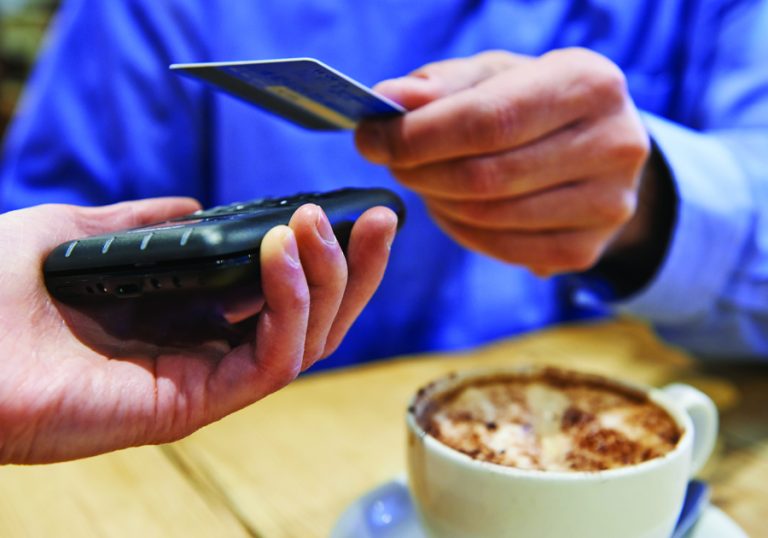COVID-19 Boosts Demand for Contactless Cards

The past decade spearheaded a revolution in payment methods and form factors around the globe, from digital wallets like Apple Pay®, Samsung Pay and Google Pay™, to contactless wearables and payment objects. Now, years in the making, the U.S. card market is finally ripe for contactless payments and widespread adoption may ramp up as a result of the coronavirus pandemic.
According to the International Card Manufacturers Association (ICMA)’s 2020 State of the Card Industry, North America ranked second (behind the Asia Pacific region) with 9.5 billion cards manufactured in 2019, which was a 3.2% increase compared to 2018. The growth was a result of accelerated contactless conversion. However, the United States continues to lag behind many other regions of the world when it comes to contactless payment adoption.
Outside of the United States, more than 40% of in-store Visa transactions occur with a tap, with Europe and Canada leading the way. U.S. issuers have been slow to catch on to the contactless card trend and consumers have yet to get comfortable with the tap-and-go solution.
“One of the reasons the U.S. is behind in adoption is a result of the contact chip liability shift, which was many years behind the rest of the world and driven by the payment brands,” said Jack Jania, vice president of product management and innovation for secure cards at CPI Card Group. “Issuers in the U.S. took about five years to convert to contact chip, which has cascaded to being approximately five years behind the rest of the world in deploying contactless payment. Also, unlike with the Europay, Mastercard and Visa (EMV) conversion, there is no legal mandate to incentivize financial institutions to convert to contactless.”
Amid the COVID-19 outbreak, Americans are reconsidering handling cash, with many people switching to contactless payments to deter the transmission of the coronavirus. This could boost awareness and demand, spurring accelerated contactless usage in the U.S.
“A dual-interface card doesn’t have to touch the point-of-sale (POS) terminal, so consumers may prefer a ‘touchless’ method,” said Jania. “Also, transaction data from Europe shows that contactless payment transactions on average are much smaller when compared to other card transactions, which suggests contactless captures small-dollar spend.”
A contactless card has both a chip and an antenna embedded within it and allows transactions to be conducted through a secure radio frequency signal (based on near-field communication specifications) between the POS terminal and the chip. A dual-interface contactless transaction transmits the same information as a contact chip transaction without a PIN. The main difference is in the speed and convenience of the transaction. Merchants and issuers benefit from faster transactions and increased transaction volumes.
Many merchants are poised to accept contactless payments as well, having converted to EMV-enabled POS terminals, which are set up to accept contactless payments using the radio frequency field generated by the terminal.
Cardholders are eager to try new contactless payment methods and form factors. The ubiquity of the “on the go” lifestyle is changing how people prefer to pay. According to CPI’s Consumer Insights Study, 72% of respondents like the idea of tapping their cards, and 65% like the idea of tapping an “object” to pay. For issuers, this translates to increased cardholder loyalty and lower attrition rates.
Consumers can tap to pay where they transact most in the United States. The majority of grocery, pharmacy and quick-service restaurants already allow customers to tap to pay at checkout. The fast-casual restaurant sector is one area driving the mobile and contactless payment revolution, primarily as a way to speed up the payment process. Contactless technology can also provide the security and transaction speed necessary for transit fare card and turnstile applications.
From wristbands to fitness trackers, watches and jewelry, there’s a large range of wearable payment devices and technology delivering a seamless checkout experience.
Providing an open-loop and closed-loop solution, CPI Card Group implements a versatile wearable chip and antenna personalization technology which allows clients to choose a form-factor. With a payment object the size of a postage stamp, everyday items can be turned into a payment device capable of making contactless transactions.
Although 60-70% of U.S. terminals are equipped with near-field communication capabilities, in many cases the functionality has not been activated. U.S. issuers and processors must work together to offer contactless options to their cardholders.
For consumers and issuers, contactless cards deliver a strong value proposition—convenience and speed, especially during concerns of the coronavirus outbreak. The contactless trend is here and its prime time for issuers to support the transition by offering dual-interface cards.
Want More Industry Insider Insights or a Glimpse into Global Card Trends?
For three decades, ICMA has represented the interests of the card manufacturing industry—which includes manufacturers, personalizers, issuers and suppliers—as its leading global association.
ICMA offers regular educational opportunities, including the web-based Card Industry Training & Education program, which provides information on key areas of the industry, as well as tutorials and webinars from industry experts. ICMA also provides reports on the card market and on personalization and fulfillment statistics to keep members informed of emerging trends and changing forecasts.
Throughout the year, ICMA members have the opportunity to share insights and knowledge by giving presentations at ICMA events, webcasts and tutorials. The organization hosts three conferences each year. The main event is the annual Card Manufacturing & Personalization EXPO and the other two conferences are CardTREX North America and CardTREX Europe.
